Research Paper: HR Strategy in Dynamic Organizational Context
VerifiedAdded on 2022/12/05
|6
|1915
|329
Report
AI Summary
This research paper conducts a brief analysis of Human Resource Architecture's influence on Human Resource Strategies in dynamic organizational contexts, emphasizing the importance of Human Resource Management practices. The paper explores strategic implementation, differentiation, and managerial significance, focusing on balancing exploitative and exploratory learning programs. The discussion centers on the role of HR strategies in enhancing organizational performance and exploring opportunities, particularly through ambidexterity—the ability to balance exploitation and exploration. The paper examines how HR systems drive employee attitudes and behaviors, the role of HR in building competitive advantages, and the challenges of implementing strategic HRM in dynamic environments. Strategies for hiring professionals, managing workforce quality, and developing sustainable company culture are also discussed, including the importance of employee engagement, performance measurement, and project-based working environments. The conclusion reiterates the significance of HR management in achieving organizational goals and the need for strategic alignment in dynamic settings.
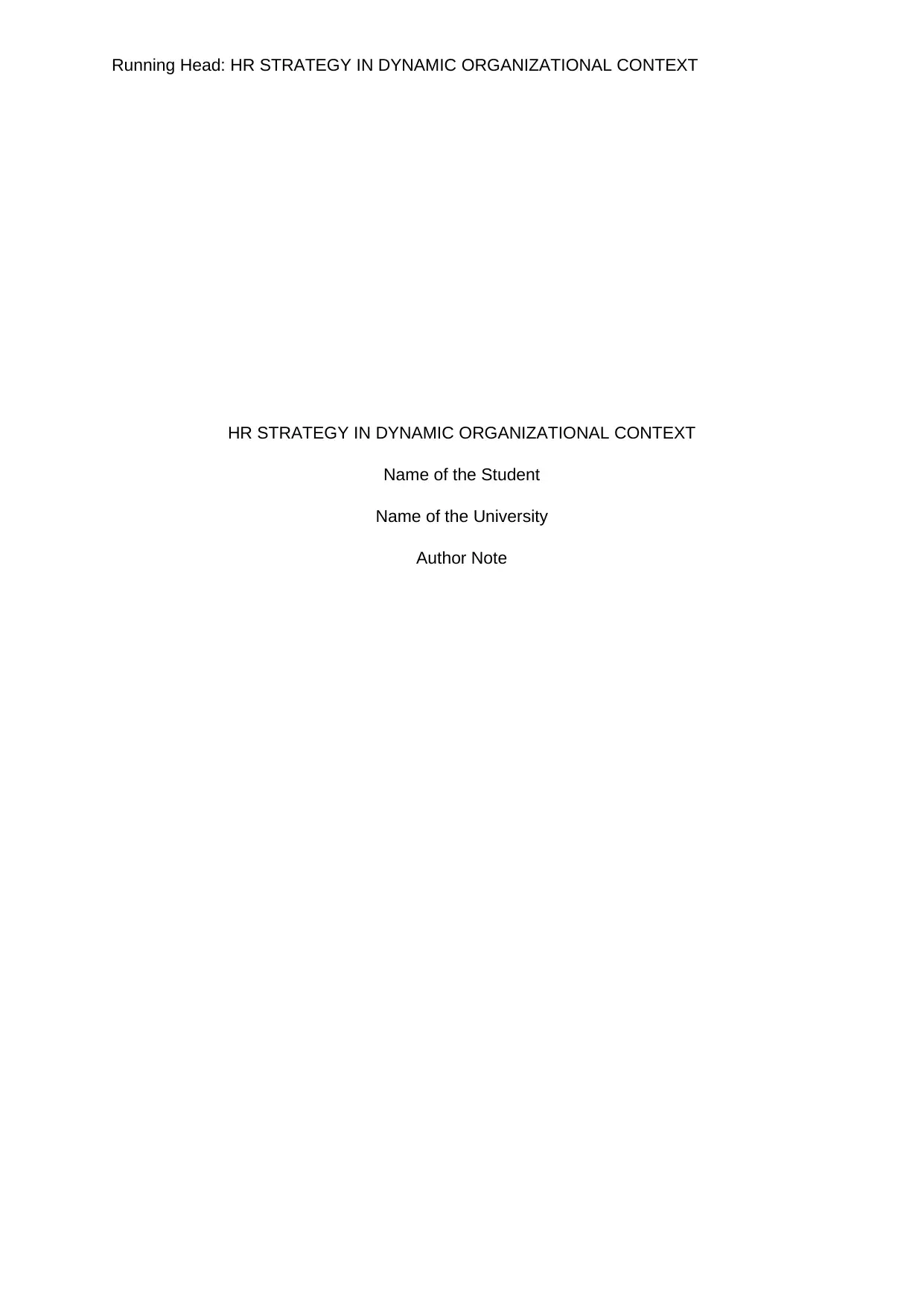
Running Head: HR STRATEGY IN DYNAMIC ORGANIZATIONAL CONTEXT
HR STRATEGY IN DYNAMIC ORGANIZATIONAL CONTEXT
Name of the Student
Name of the University
Author Note
HR STRATEGY IN DYNAMIC ORGANIZATIONAL CONTEXT
Name of the Student
Name of the University
Author Note
Paraphrase This Document
Need a fresh take? Get an instant paraphrase of this document with our AI Paraphraser
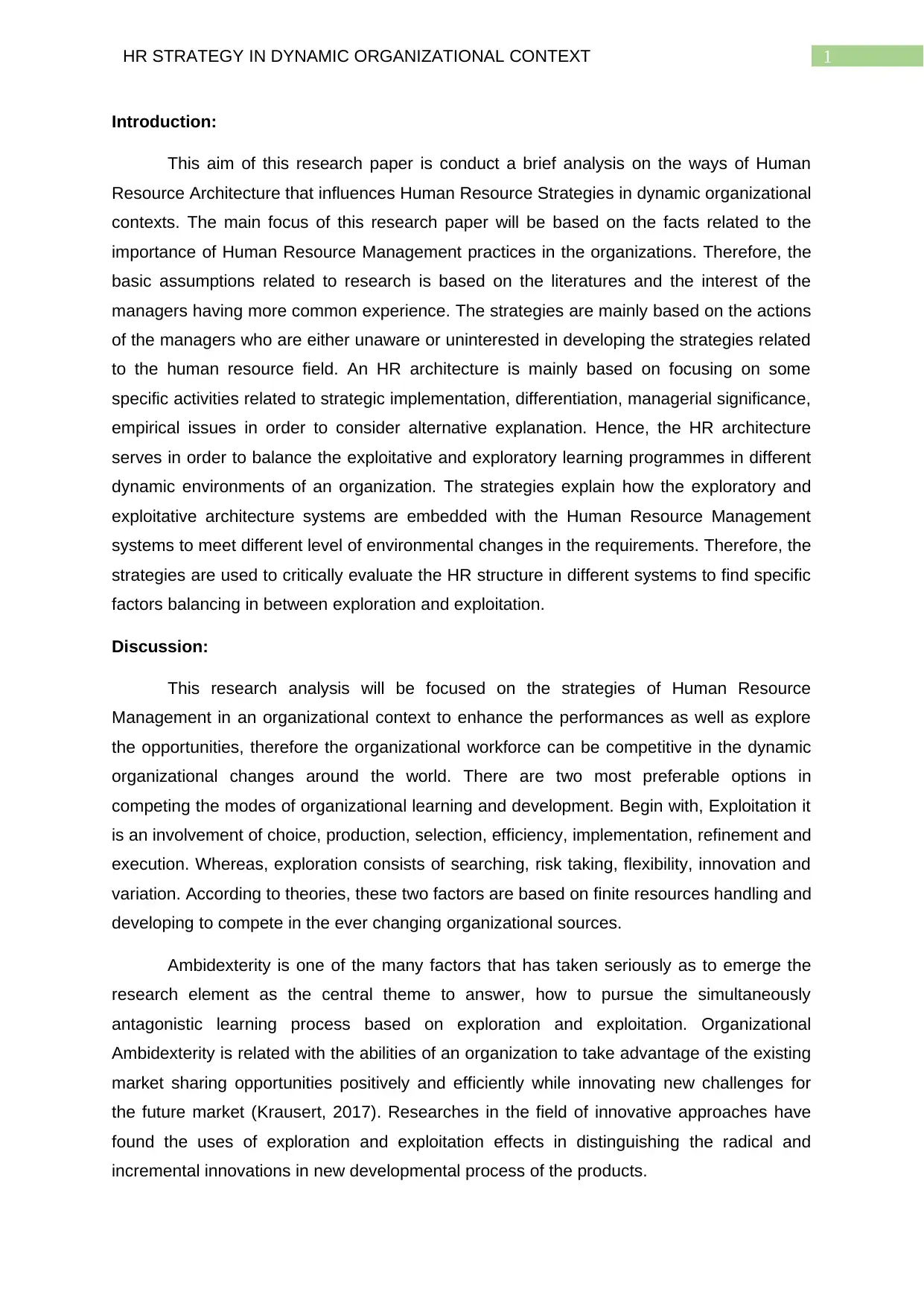
1HR STRATEGY IN DYNAMIC ORGANIZATIONAL CONTEXT
Introduction:
This aim of this research paper is conduct a brief analysis on the ways of Human
Resource Architecture that influences Human Resource Strategies in dynamic organizational
contexts. The main focus of this research paper will be based on the facts related to the
importance of Human Resource Management practices in the organizations. Therefore, the
basic assumptions related to research is based on the literatures and the interest of the
managers having more common experience. The strategies are mainly based on the actions
of the managers who are either unaware or uninterested in developing the strategies related
to the human resource field. An HR architecture is mainly based on focusing on some
specific activities related to strategic implementation, differentiation, managerial significance,
empirical issues in order to consider alternative explanation. Hence, the HR architecture
serves in order to balance the exploitative and exploratory learning programmes in different
dynamic environments of an organization. The strategies explain how the exploratory and
exploitative architecture systems are embedded with the Human Resource Management
systems to meet different level of environmental changes in the requirements. Therefore, the
strategies are used to critically evaluate the HR structure in different systems to find specific
factors balancing in between exploration and exploitation.
Discussion:
This research analysis will be focused on the strategies of Human Resource
Management in an organizational context to enhance the performances as well as explore
the opportunities, therefore the organizational workforce can be competitive in the dynamic
organizational changes around the world. There are two most preferable options in
competing the modes of organizational learning and development. Begin with, Exploitation it
is an involvement of choice, production, selection, efficiency, implementation, refinement and
execution. Whereas, exploration consists of searching, risk taking, flexibility, innovation and
variation. According to theories, these two factors are based on finite resources handling and
developing to compete in the ever changing organizational sources.
Ambidexterity is one of the many factors that has taken seriously as to emerge the
research element as the central theme to answer, how to pursue the simultaneously
antagonistic learning process based on exploration and exploitation. Organizational
Ambidexterity is related with the abilities of an organization to take advantage of the existing
market sharing opportunities positively and efficiently while innovating new challenges for
the future market (Krausert, 2017). Researches in the field of innovative approaches have
found the uses of exploration and exploitation effects in distinguishing the radical and
incremental innovations in new developmental process of the products.
Introduction:
This aim of this research paper is conduct a brief analysis on the ways of Human
Resource Architecture that influences Human Resource Strategies in dynamic organizational
contexts. The main focus of this research paper will be based on the facts related to the
importance of Human Resource Management practices in the organizations. Therefore, the
basic assumptions related to research is based on the literatures and the interest of the
managers having more common experience. The strategies are mainly based on the actions
of the managers who are either unaware or uninterested in developing the strategies related
to the human resource field. An HR architecture is mainly based on focusing on some
specific activities related to strategic implementation, differentiation, managerial significance,
empirical issues in order to consider alternative explanation. Hence, the HR architecture
serves in order to balance the exploitative and exploratory learning programmes in different
dynamic environments of an organization. The strategies explain how the exploratory and
exploitative architecture systems are embedded with the Human Resource Management
systems to meet different level of environmental changes in the requirements. Therefore, the
strategies are used to critically evaluate the HR structure in different systems to find specific
factors balancing in between exploration and exploitation.
Discussion:
This research analysis will be focused on the strategies of Human Resource
Management in an organizational context to enhance the performances as well as explore
the opportunities, therefore the organizational workforce can be competitive in the dynamic
organizational changes around the world. There are two most preferable options in
competing the modes of organizational learning and development. Begin with, Exploitation it
is an involvement of choice, production, selection, efficiency, implementation, refinement and
execution. Whereas, exploration consists of searching, risk taking, flexibility, innovation and
variation. According to theories, these two factors are based on finite resources handling and
developing to compete in the ever changing organizational sources.
Ambidexterity is one of the many factors that has taken seriously as to emerge the
research element as the central theme to answer, how to pursue the simultaneously
antagonistic learning process based on exploration and exploitation. Organizational
Ambidexterity is related with the abilities of an organization to take advantage of the existing
market sharing opportunities positively and efficiently while innovating new challenges for
the future market (Krausert, 2017). Researches in the field of innovative approaches have
found the uses of exploration and exploitation effects in distinguishing the radical and
incremental innovations in new developmental process of the products.
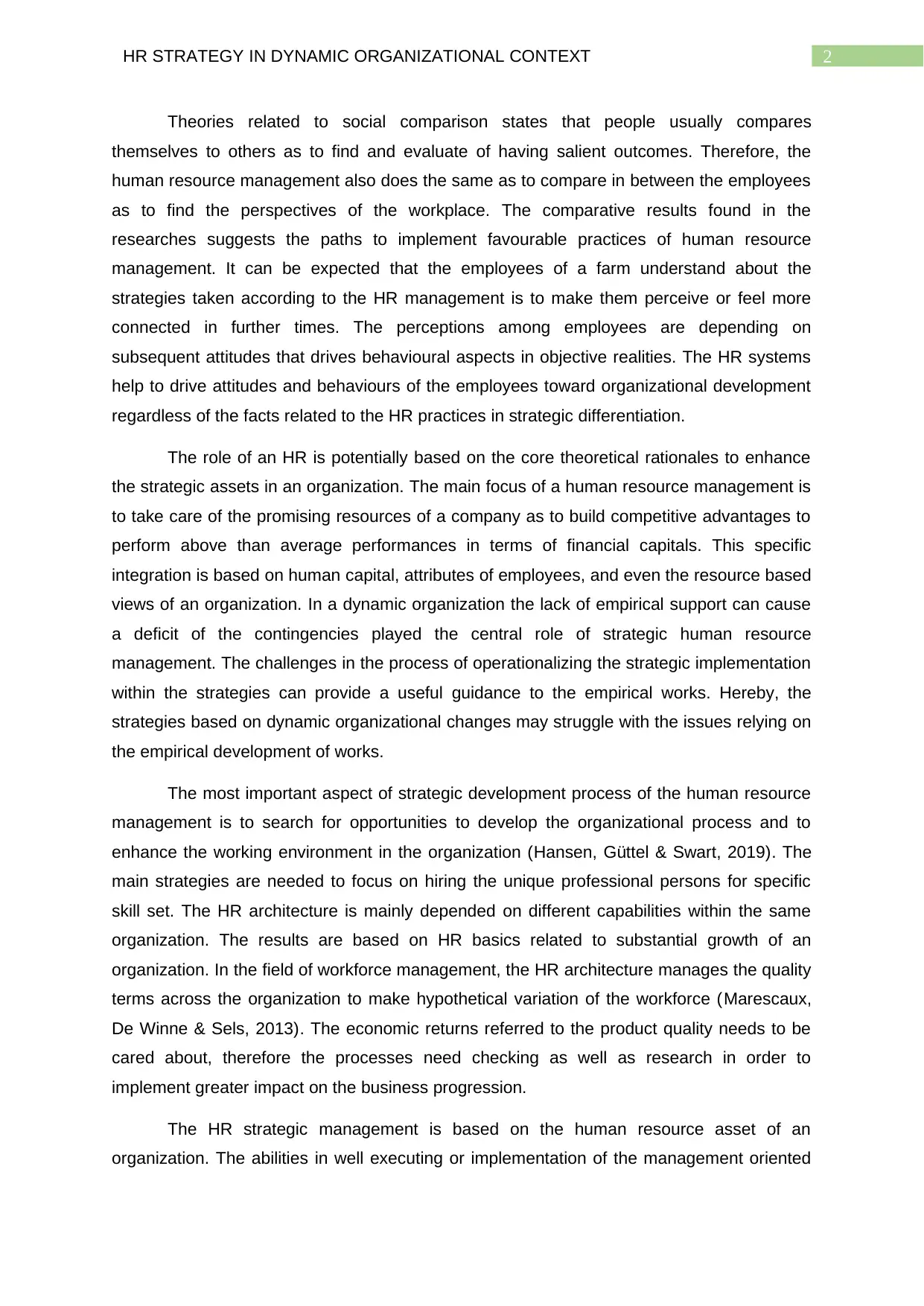
2HR STRATEGY IN DYNAMIC ORGANIZATIONAL CONTEXT
Theories related to social comparison states that people usually compares
themselves to others as to find and evaluate of having salient outcomes. Therefore, the
human resource management also does the same as to compare in between the employees
as to find the perspectives of the workplace. The comparative results found in the
researches suggests the paths to implement favourable practices of human resource
management. It can be expected that the employees of a farm understand about the
strategies taken according to the HR management is to make them perceive or feel more
connected in further times. The perceptions among employees are depending on
subsequent attitudes that drives behavioural aspects in objective realities. The HR systems
help to drive attitudes and behaviours of the employees toward organizational development
regardless of the facts related to the HR practices in strategic differentiation.
The role of an HR is potentially based on the core theoretical rationales to enhance
the strategic assets in an organization. The main focus of a human resource management is
to take care of the promising resources of a company as to build competitive advantages to
perform above than average performances in terms of financial capitals. This specific
integration is based on human capital, attributes of employees, and even the resource based
views of an organization. In a dynamic organization the lack of empirical support can cause
a deficit of the contingencies played the central role of strategic human resource
management. The challenges in the process of operationalizing the strategic implementation
within the strategies can provide a useful guidance to the empirical works. Hereby, the
strategies based on dynamic organizational changes may struggle with the issues relying on
the empirical development of works.
The most important aspect of strategic development process of the human resource
management is to search for opportunities to develop the organizational process and to
enhance the working environment in the organization (Hansen, Güttel & Swart, 2019). The
main strategies are needed to focus on hiring the unique professional persons for specific
skill set. The HR architecture is mainly depended on different capabilities within the same
organization. The results are based on HR basics related to substantial growth of an
organization. In the field of workforce management, the HR architecture manages the quality
terms across the organization to make hypothetical variation of the workforce (Marescaux,
De Winne & Sels, 2013). The economic returns referred to the product quality needs to be
cared about, therefore the processes need checking as well as research in order to
implement greater impact on the business progression.
The HR strategic management is based on the human resource asset of an
organization. The abilities in well executing or implementation of the management oriented
Theories related to social comparison states that people usually compares
themselves to others as to find and evaluate of having salient outcomes. Therefore, the
human resource management also does the same as to compare in between the employees
as to find the perspectives of the workplace. The comparative results found in the
researches suggests the paths to implement favourable practices of human resource
management. It can be expected that the employees of a farm understand about the
strategies taken according to the HR management is to make them perceive or feel more
connected in further times. The perceptions among employees are depending on
subsequent attitudes that drives behavioural aspects in objective realities. The HR systems
help to drive attitudes and behaviours of the employees toward organizational development
regardless of the facts related to the HR practices in strategic differentiation.
The role of an HR is potentially based on the core theoretical rationales to enhance
the strategic assets in an organization. The main focus of a human resource management is
to take care of the promising resources of a company as to build competitive advantages to
perform above than average performances in terms of financial capitals. This specific
integration is based on human capital, attributes of employees, and even the resource based
views of an organization. In a dynamic organization the lack of empirical support can cause
a deficit of the contingencies played the central role of strategic human resource
management. The challenges in the process of operationalizing the strategic implementation
within the strategies can provide a useful guidance to the empirical works. Hereby, the
strategies based on dynamic organizational changes may struggle with the issues relying on
the empirical development of works.
The most important aspect of strategic development process of the human resource
management is to search for opportunities to develop the organizational process and to
enhance the working environment in the organization (Hansen, Güttel & Swart, 2019). The
main strategies are needed to focus on hiring the unique professional persons for specific
skill set. The HR architecture is mainly depended on different capabilities within the same
organization. The results are based on HR basics related to substantial growth of an
organization. In the field of workforce management, the HR architecture manages the quality
terms across the organization to make hypothetical variation of the workforce (Marescaux,
De Winne & Sels, 2013). The economic returns referred to the product quality needs to be
cared about, therefore the processes need checking as well as research in order to
implement greater impact on the business progression.
The HR strategic management is based on the human resource asset of an
organization. The abilities in well executing or implementation of the management oriented
⊘ This is a preview!⊘
Do you want full access?
Subscribe today to unlock all pages.

Trusted by 1+ million students worldwide
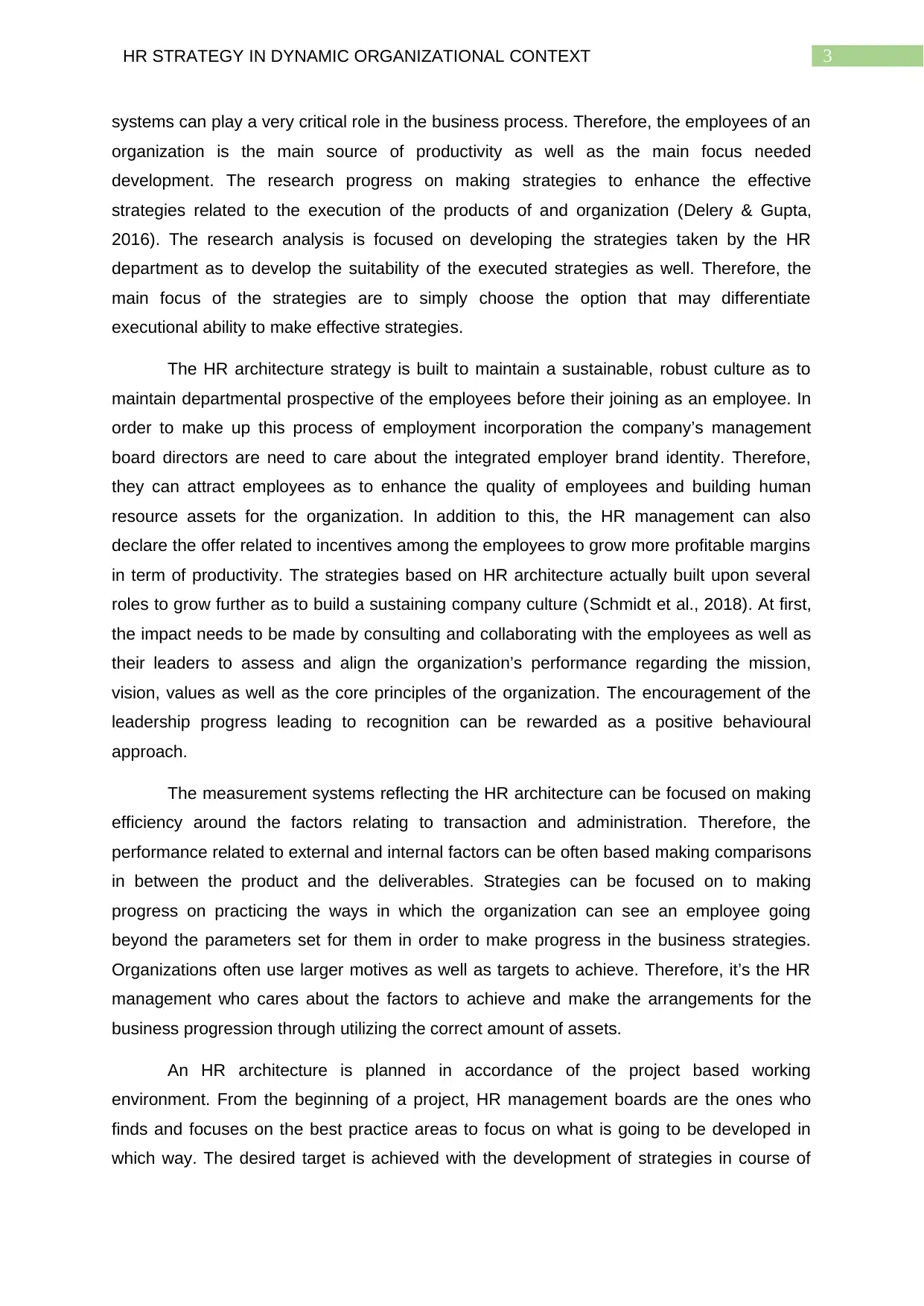
3HR STRATEGY IN DYNAMIC ORGANIZATIONAL CONTEXT
systems can play a very critical role in the business process. Therefore, the employees of an
organization is the main source of productivity as well as the main focus needed
development. The research progress on making strategies to enhance the effective
strategies related to the execution of the products of and organization (Delery & Gupta,
2016). The research analysis is focused on developing the strategies taken by the HR
department as to develop the suitability of the executed strategies as well. Therefore, the
main focus of the strategies are to simply choose the option that may differentiate
executional ability to make effective strategies.
The HR architecture strategy is built to maintain a sustainable, robust culture as to
maintain departmental prospective of the employees before their joining as an employee. In
order to make up this process of employment incorporation the company’s management
board directors are need to care about the integrated employer brand identity. Therefore,
they can attract employees as to enhance the quality of employees and building human
resource assets for the organization. In addition to this, the HR management can also
declare the offer related to incentives among the employees to grow more profitable margins
in term of productivity. The strategies based on HR architecture actually built upon several
roles to grow further as to build a sustaining company culture (Schmidt et al., 2018). At first,
the impact needs to be made by consulting and collaborating with the employees as well as
their leaders to assess and align the organization’s performance regarding the mission,
vision, values as well as the core principles of the organization. The encouragement of the
leadership progress leading to recognition can be rewarded as a positive behavioural
approach.
The measurement systems reflecting the HR architecture can be focused on making
efficiency around the factors relating to transaction and administration. Therefore, the
performance related to external and internal factors can be often based making comparisons
in between the product and the deliverables. Strategies can be focused on to making
progress on practicing the ways in which the organization can see an employee going
beyond the parameters set for them in order to make progress in the business strategies.
Organizations often use larger motives as well as targets to achieve. Therefore, it’s the HR
management who cares about the factors to achieve and make the arrangements for the
business progression through utilizing the correct amount of assets.
An HR architecture is planned in accordance of the project based working
environment. From the beginning of a project, HR management boards are the ones who
finds and focuses on the best practice areas to focus on what is going to be developed in
which way. The desired target is achieved with the development of strategies in course of
systems can play a very critical role in the business process. Therefore, the employees of an
organization is the main source of productivity as well as the main focus needed
development. The research progress on making strategies to enhance the effective
strategies related to the execution of the products of and organization (Delery & Gupta,
2016). The research analysis is focused on developing the strategies taken by the HR
department as to develop the suitability of the executed strategies as well. Therefore, the
main focus of the strategies are to simply choose the option that may differentiate
executional ability to make effective strategies.
The HR architecture strategy is built to maintain a sustainable, robust culture as to
maintain departmental prospective of the employees before their joining as an employee. In
order to make up this process of employment incorporation the company’s management
board directors are need to care about the integrated employer brand identity. Therefore,
they can attract employees as to enhance the quality of employees and building human
resource assets for the organization. In addition to this, the HR management can also
declare the offer related to incentives among the employees to grow more profitable margins
in term of productivity. The strategies based on HR architecture actually built upon several
roles to grow further as to build a sustaining company culture (Schmidt et al., 2018). At first,
the impact needs to be made by consulting and collaborating with the employees as well as
their leaders to assess and align the organization’s performance regarding the mission,
vision, values as well as the core principles of the organization. The encouragement of the
leadership progress leading to recognition can be rewarded as a positive behavioural
approach.
The measurement systems reflecting the HR architecture can be focused on making
efficiency around the factors relating to transaction and administration. Therefore, the
performance related to external and internal factors can be often based making comparisons
in between the product and the deliverables. Strategies can be focused on to making
progress on practicing the ways in which the organization can see an employee going
beyond the parameters set for them in order to make progress in the business strategies.
Organizations often use larger motives as well as targets to achieve. Therefore, it’s the HR
management who cares about the factors to achieve and make the arrangements for the
business progression through utilizing the correct amount of assets.
An HR architecture is planned in accordance of the project based working
environment. From the beginning of a project, HR management boards are the ones who
finds and focuses on the best practice areas to focus on what is going to be developed in
which way. The desired target is achieved with the development of strategies in course of
Paraphrase This Document
Need a fresh take? Get an instant paraphrase of this document with our AI Paraphraser

4HR STRATEGY IN DYNAMIC ORGANIZATIONAL CONTEXT
time rather than just ensuring the proposition regarding the project valuation. Hence, the role
of the strategies are solely focused on to making a dynamic progression in the developing
work culture of an organization.
Conclusion:
This research paper was focused on the facts in relation with the importance of
Human Resource Management practices in the organizations. The strategies described
were focused on the actions of the managers who were either unaware or uninterested in
developing the strategies related to the human resource field. HR architecture strategies
were mainly focused on some specific activities related to strategic implementation,
differentiation, managerial significance, empirical issues in order to consider alternative
explanation. The strategies explain how the exploratory and exploitative architecture
systems are embedded with the Human Resource Management systems to meet different
level of environmental changes in the requirements. The HR architecture was mainly
depended on different capabilities within the same organization. The results were based on
HR basics related to substantial growth of an organization.
time rather than just ensuring the proposition regarding the project valuation. Hence, the role
of the strategies are solely focused on to making a dynamic progression in the developing
work culture of an organization.
Conclusion:
This research paper was focused on the facts in relation with the importance of
Human Resource Management practices in the organizations. The strategies described
were focused on the actions of the managers who were either unaware or uninterested in
developing the strategies related to the human resource field. HR architecture strategies
were mainly focused on some specific activities related to strategic implementation,
differentiation, managerial significance, empirical issues in order to consider alternative
explanation. The strategies explain how the exploratory and exploitative architecture
systems are embedded with the Human Resource Management systems to meet different
level of environmental changes in the requirements. The HR architecture was mainly
depended on different capabilities within the same organization. The results were based on
HR basics related to substantial growth of an organization.
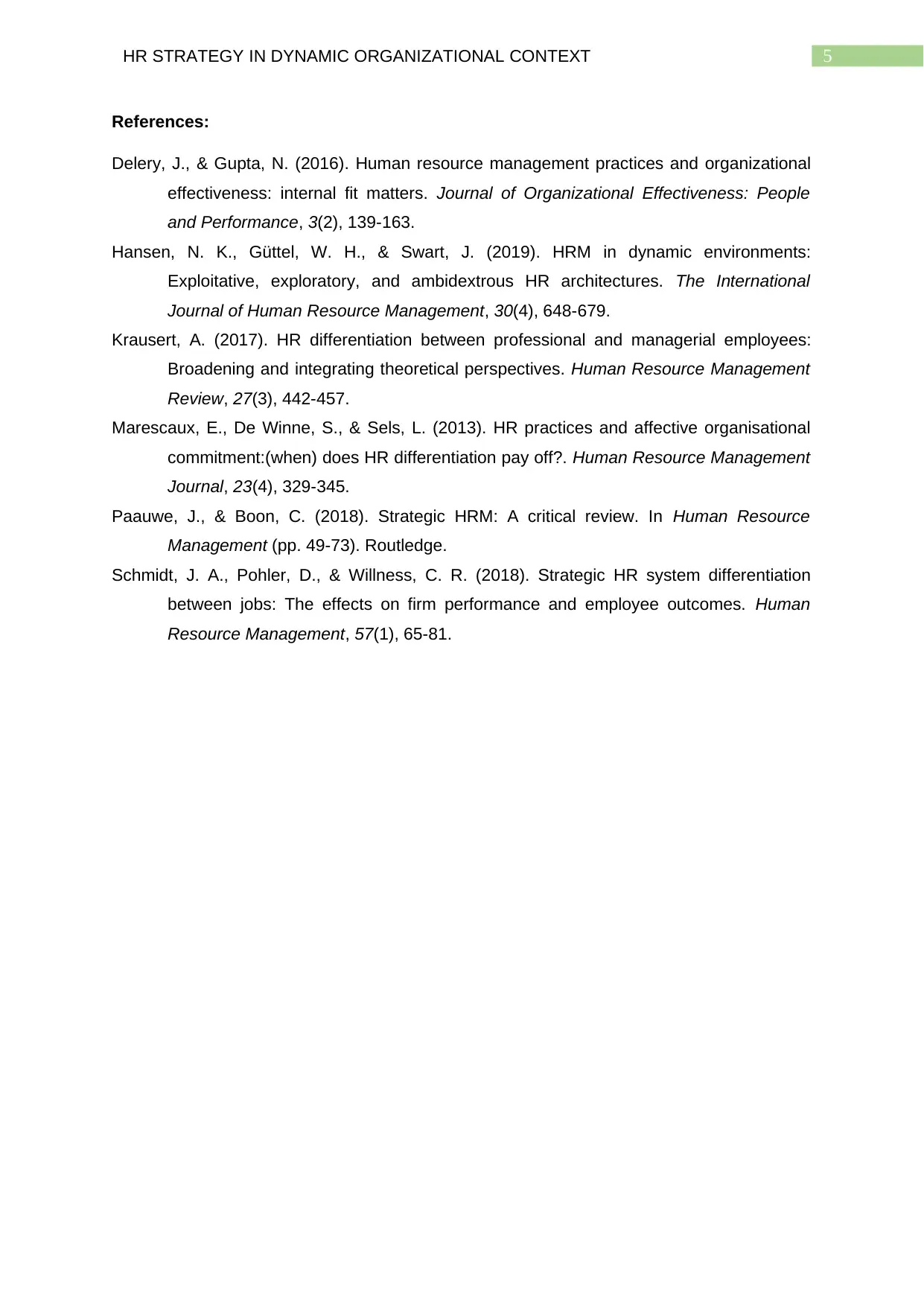
5HR STRATEGY IN DYNAMIC ORGANIZATIONAL CONTEXT
References:
Delery, J., & Gupta, N. (2016). Human resource management practices and organizational
effectiveness: internal fit matters. Journal of Organizational Effectiveness: People
and Performance, 3(2), 139-163.
Hansen, N. K., Güttel, W. H., & Swart, J. (2019). HRM in dynamic environments:
Exploitative, exploratory, and ambidextrous HR architectures. The International
Journal of Human Resource Management, 30(4), 648-679.
Krausert, A. (2017). HR differentiation between professional and managerial employees:
Broadening and integrating theoretical perspectives. Human Resource Management
Review, 27(3), 442-457.
Marescaux, E., De Winne, S., & Sels, L. (2013). HR practices and affective organisational
commitment:(when) does HR differentiation pay off?. Human Resource Management
Journal, 23(4), 329-345.
Paauwe, J., & Boon, C. (2018). Strategic HRM: A critical review. In Human Resource
Management (pp. 49-73). Routledge.
Schmidt, J. A., Pohler, D., & Willness, C. R. (2018). Strategic HR system differentiation
between jobs: The effects on firm performance and employee outcomes. Human
Resource Management, 57(1), 65-81.
References:
Delery, J., & Gupta, N. (2016). Human resource management practices and organizational
effectiveness: internal fit matters. Journal of Organizational Effectiveness: People
and Performance, 3(2), 139-163.
Hansen, N. K., Güttel, W. H., & Swart, J. (2019). HRM in dynamic environments:
Exploitative, exploratory, and ambidextrous HR architectures. The International
Journal of Human Resource Management, 30(4), 648-679.
Krausert, A. (2017). HR differentiation between professional and managerial employees:
Broadening and integrating theoretical perspectives. Human Resource Management
Review, 27(3), 442-457.
Marescaux, E., De Winne, S., & Sels, L. (2013). HR practices and affective organisational
commitment:(when) does HR differentiation pay off?. Human Resource Management
Journal, 23(4), 329-345.
Paauwe, J., & Boon, C. (2018). Strategic HRM: A critical review. In Human Resource
Management (pp. 49-73). Routledge.
Schmidt, J. A., Pohler, D., & Willness, C. R. (2018). Strategic HR system differentiation
between jobs: The effects on firm performance and employee outcomes. Human
Resource Management, 57(1), 65-81.
⊘ This is a preview!⊘
Do you want full access?
Subscribe today to unlock all pages.

Trusted by 1+ million students worldwide
1 out of 6
Related Documents
Your All-in-One AI-Powered Toolkit for Academic Success.
+13062052269
info@desklib.com
Available 24*7 on WhatsApp / Email
![[object Object]](/_next/static/media/star-bottom.7253800d.svg)
Unlock your academic potential
Copyright © 2020–2025 A2Z Services. All Rights Reserved. Developed and managed by ZUCOL.





